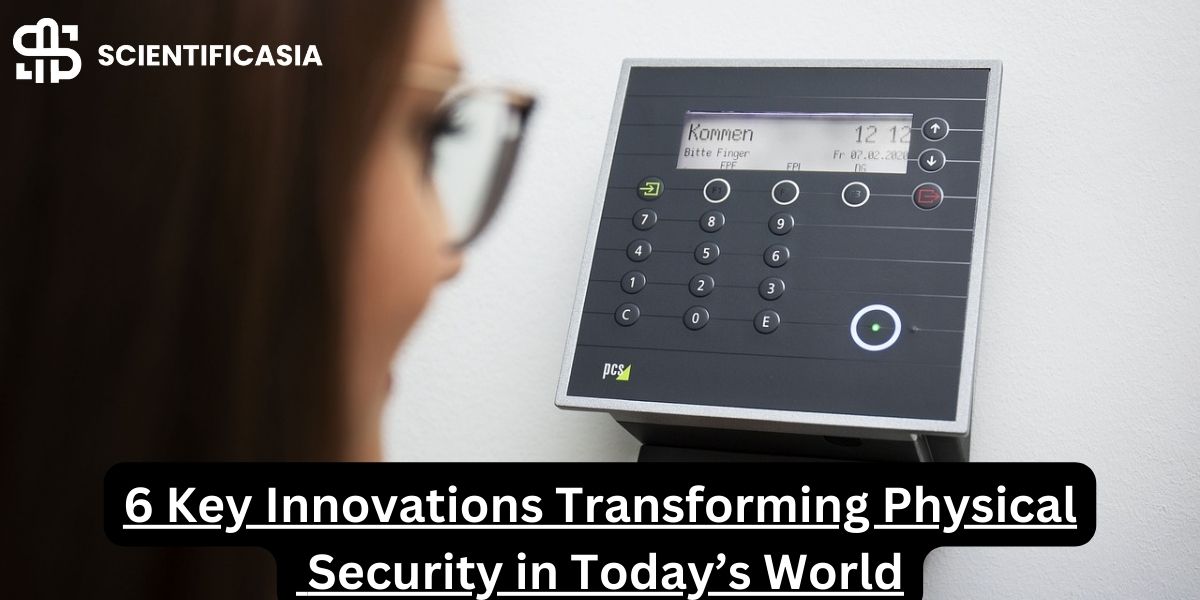Even though, in general, crime is on the rise, security innovations are helping to counteract threats like burglaries and make the world a safer place.
As technology becomes more sophisticated and prices fall for security innovations already in use (such as biometric access control), we can expect innovative physical security solutions to be much more widespread soon.
Here are six key innovations you should know about.
1. Biometric Access Control
Everyone seems to be talking about biometrics, and with good reason. After all, they’re helping to enhance security in several ways, from smartphone access to home entry.
If you’re not aware, biometrics use unique physical or behavioral characteristics to grant access.
Here are some key features that are transforming physical security.
Fingerprint Scanners
Your fingerprint is unique. Therefore, when fingerprint scanners are in place in either commercial or residential buildings, only authorized people can access the spaces by scanning their prints.
The system stores your fingerprint, so all you need to do is scan the tip of your finger for the access system to grant you entry.
Plus, like other biometric access tools, the days of fumbling for keys are long gone – which means access isn’t just safer. It’s also speedier than Speedy Gonzales!
Facial Recognition Tools
Yes, your face is unique too! Facial recognition works by capturing an image of a person’s face and converting it into a digital code. It then compares this code against a database of stored facial data to find a match, identifying or verifying the individual.
Again, like fingerprint scanners, facial recognition tools ensure only authorized access. They’re already gaining popularity in commercial properties, but it shouldn’t be long before they’re commonly used in residential buildings too.
Iris Scanners
Like fingerprints and faces, no two irises are alike. What is iris scanning? Well, it involves capturing a high-resolution image of the eye and analyzing the unique patterns in the colored ring around the pupil.
These patterns are converted into digital code, which is then compared to stored codes for identification or verification purposes. The future of security is in the eye of the beholder!
Voice Recognition
Your voice – just like your iris, face, and fingerprint – is unique. So, yes, voice recognition is another form of biometric security that is gaining ground. It uses vocal patterns for identity verification. So, if an unauthorized person tries to gain access, they won’t be able to do so.
2. AI-Powered Surveillance Cameras
Surveillance cameras have come a long way since the first CCTV models. Using artificial intelligence, surveillance cameras analyze video feeds in real-time. They can detect unusual activities, recognize faces, and identify potential threats – all without the need for human intervention.
These systems reduce false alarms and improve response times by focusing on relevant events, making them invaluable for modern physical security setups.
Benefits include:
- Real-time threat detection. AI-powered cameras can instantly spot suspicious activities.
- Reduced false alarms. Enhanced accuracy means fewer unnecessary alerts.
- Automated monitoring. These cameras decrease the need for constant human supervision.
- Facial recognition capabilities. With facial recognition, AI-powered surveillance cameras can identify individuals quickly and efficiently.
- Scalability. These innovative cameras can easily integrate into existing systems and expand as needed.
3. Thermal Imaging Cameras
The thermal imaging camera is another type of camera that is making waves in the security game. How do they work? Well, in basic terms, they detect heat signatures. That means they are highly effective for security in low-light or obscured conditions.
They capture temperature variations to identify intruders or unusual activities that traditional cameras might miss.
These cameras are ideal for perimeter monitoring and critical infrastructure protection. They enhance situational awareness and can operate in diverse weather conditions. Therefore, they provide reliable surveillance around the clock.
4. Security Drones
Drones have been revolutionizing various industries and practices. For instance, filmmakers and photographers can gain stunning aerial shots and retail outlets can deliver goods more quickly. Drones are also ideal for perimeter security; especially in commercial buildings.
They offer a flexible and dynamic approach to monitoring large or hard-to-reach areas. Equipped with cameras and sensors, they can patrol autonomously, providing live video feeds and alerting security personnel to any anomalies.
These drones enhance surveillance efficiency by covering ground faster than traditional methods and can be programmed to follow specific routes or respond to detected threats immediately.
In addition to the benefits of extended surveillance coverage and rapid threat response, they are
cost-effective, as they reduce the need for extensive stationary camera systems.
5. Smart Locks
The best deadbolt locks for front doors (which are not spring-activated and, therefore, they’re incredibly effective in preventing unauthorized access to both commercial and residential properties) have been around for some time. And they undoubtedly have a place in the future of physical security. But when it comes to modern innovations, smart locks are proving to be a hit.
Smart locks and keyless entry systems provide advanced security by using digital credentials, such as mobile apps or keycards, to grant access.
These systems allow property managers to remotely control and monitor entry points, ensuring only authorized individuals gain access.
Additionally, they can integrate with other smart building technologies for enhanced convenience and security features like audit trails and real-time notifications of lock status changes.
6. Remote Guarding Services
Lastly, remote guarding services utilize off-site security professionals to monitor surveillance systems and respond to alerts in real-time.
These services combine human expertise with advanced technology, providing an efficient and cost-effective solution for maintaining security.
Some of the key benefits of remote guarding services are as follows:
- 24/7 monitoring ensures constant vigilance without the need for on-site personnel.
- Guards can quickly assess and address potential threats.
- They reduce the expense associated with employing full-time, on-site guards.
Final Thoughts
As we have seen, physical security innovations are transforming our approach to safety. From biometrics to AI, the future looks promising and more secure. As these technologies become more widespread and affordable, they will increasingly shape how we protect our homes and businesses.
FAQs
What does the future of physical security look like?
The future of physical security is moving toward smarter, more integrated systems that use advanced technologies like biometrics, AI, and remote monitoring to provide comprehensive protection.
How do modern security innovations impact daily life?
Modern security innovations enhance daily life by offering more convenient and reliable ways to secure homes and businesses, reducing the risk of unauthorized access and increasing overall safety.
Why is technology important in physical security?
Technology plays a crucial role in physical security by enabling faster threat detection, improving accuracy in identifying risks, and allowing for scalable solutions that can adapt to various environments.
















